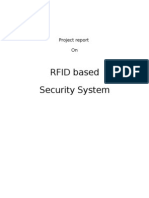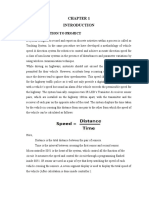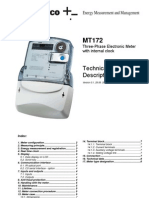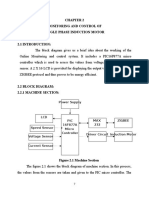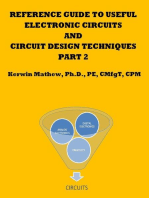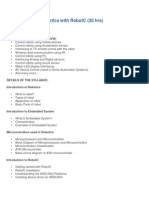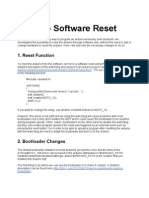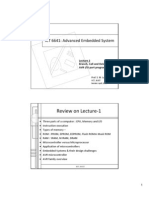Design and Implementation of Digital Trigger Circuit For Converter
Uploaded by
Bilal Ali AhmadDesign and Implementation of Digital Trigger Circuit For Converter
Uploaded by
Bilal Ali AhmadInternational Journal of Engineering Research & Technology (IJERT) ISSN: 2278-0181 Vol.
1 Issue 3, May 2012
Design and Implementation of Digital Trigger Circuit for Converter
Shashikant V. Lahade Student of M.Tech. , Department of Electronics and Tele-communication, Government College of Engineering, Amravati, Maharashtra, India. S. R. Hirekhan Associate Professor, Department of Electronics and Tele-communication, Government College of Engineering, Amravati, Maharashtra, India. C. Y. Bedare Managing Director, Bedare Electronics pvt. ltd. Nagpur, Maharashtra, India.
Abstract Controlled power is a fundamental prerequisite of various sectors. A scheme of microcontroller based firing angle control, using ATmega 32 MCU & associated hardware circuitry is discussed. Basic idea is to achieve reliable, consistent control that will result in improved performance of converter. Set-up consists of ATmega-32 controller, LCD display for displaying firing angle, transistorized conditioning circuit, main rectifier module and input from user in the form of analog voltage for firing angle control. Integration of these modules will result in full controlled converter with superior performance over other ordinary control techniques.
outputs of microcontroller port. These pulse trains can be manipulated with software program for microcontroller. These manipulated pulses will be used through proper isolation, for triggering SCR gates thereby controlling converters output. Synchronization will be achieved by using sample from raw AC signal, converting it in square wave pulse & using it for interrupt of MCU. Firing angle control is achieved by varying analog voltage (0-5 V), which is converted by ADC of ATmega-32 into digital value, and this value is used as firing angle by proper mathematical calculation to trigger the converter circuit at desired firing angle, thereby controlling the output voltage. In section-I the overview of power electronic technology is discussed along with its importance in household and commercial application. Hardware and software platform for digital trigger circuit is discussed in Section-II. Section-III gives a detail view of Methodology incorporated in project. Results are discussed in section IV. Section V concludes the paper.
1. Introduction
In industrial, agronomic production and house hold applications the controlled powers through electronic technology have been widely used. The power is provided to the application via rectifier, cycloconverter, frequency converter and inverter. Among these four types, rectifier is generally used in the equipment, where in trigger circuit is very important. Because of advances in the switching technology the analog trigger circuits are replaced by digital trigger circuits [8]. The circuit like converter, cycloconverter, rectifier and inverter make use of thyristor as an elementary unit. The three terminal thyristors having additional terminal gate, along with anode and cathode; is employed to trigger the thyristor at a precise angle, known as firing mechanism [10]. It is observed that in analog triggering circuit, trigger circuit is too complex with many components; which may lead to debugging difficulties, uneven spacing of the adjacent trigger pulses and shifting phase inaccuracies. Hence digital trigger mechanism is designed which overcomes the limitations of analog trigger circuit. Using ATMega-32 controller programmable pulse train is be generated in desired sequence as six
.
2. Hardwar and software platform 2.1 Embedded board
Embedded board based on AVR microcontroller is used, it contains several sensors, LCD screen, LEDs, etc. all on the same board. No need to connect any additional hardware for multiple applications. Board has various features like: AVR ATmega32 microcontroller, 2-line LCD display, 8 LEDs, temperature sensor, RTC (Real Time Clock) chip, serial port, four on-board keys for input, external interrupt pins, operation using 9V battery or AC adapter.
2.2 Software Platform
WinAVR is a collection of executable software development tools for the ATmega AVR processor hosted on Windows and Cygwin is software that
www.ijert.org
International Journal of Engineering Research & Technology (IJERT) ISSN: 2278-0181 Vol. 1 Issue 3, May 2012
provides a Unix-like environment and software tool set to users of any modern version of MS-Windows.
3. Methodology
Set-up is consist of ATMega-32 controller, Analog voltage (0-5 V) is for operation control, LCD display for displaying firing angle, transistorized conditioning circuit & main rectifier module. Integration of these modules will result in Full controlled converter with superior performance over other ordinary control techniques.
resistor divider network consisting of R1 and R12. Diode is for the rectification followed by resistor divider network to scale down the voltage level. Transistor 2N2222 is used for generation of square wave which acts as a switch. At collector terminal we have square wave with amplitude of 4.88 volt.
Figure 2 Zero crossing detector
Figure 1 Block Diagram
3.1 0-5 V controlling voltage
Analog Voltage (0-5 V) is used for controlling the converter power, ADC of Atmege-32 microcontroller is 10 bit resolution. Port A is used for ADC in Atmege32. Channel 0 and 1 are reserved for light and temperature sensor, thats why channel 2 is used for accepting analog voltage. Analog Voltage (0-5 V) is converted in to (0-1023) count. Analog voltage is provided to one of the channel of ADC port. As per variation in the analog voltage there is change of digital value. ADC conversion takes around 250 micro second. PWM is achieved with the help of variable controlling voltage. Figure 3 Waveform of ZCD Fig 2 shows circuit diagram of ZCD and Fig 3 provides the waveforms of AC signal and square wave generated by ZCD.
3.3 Microcontroller Atmega-32
It is a high-performance, Low-power AVR 8-bit Microcontroller having advanced RISC architecture, 32K bytes of in-system self-programmable flash, 1024 Bytes EEPROM , 2K byte internal SRAM. 8-channel 10-bit ADC, External and Internal Interrupt Sources 32 Programmable I/O Lines. It accepts analog controlling voltage form ADC channel 2, which is converted in to digital value, this value is used for PWM. Signal from zero crossing detectors is given at INT0 pin of ATmega-32. Falling edge of the square wave is detected as the interrupt. In interrupt subroutine first trigger pulse is output.
3.2 Zero Crossing Detector circuit
Zero Crossing Detector circuit distinguish between start of positive half cycle or negative half cycles. To have full control over the firing angle of the SCR, it is necessary to precisely detect the zero crossing of the sinusoidal input. Signal from mains is provided as a input, which is scaled down by transformer to the alternating voltage of lower value around 12V. It is necessary that the output at the secondary of T remain in-phase with the input on its primary. This scaled down and isolated AC input is then scaled down further by using a
.
3.4 Display
Embedded board with 2-line LCD display is used for showing the ADC value and respective firing angle. Values on the display are instantaneous with the change in the analog voltage values of ADC and firing angle changes.
www.ijert.org
International Journal of Engineering Research & Technology (IJERT) ISSN: 2278-0181 Vol. 1 Issue 3, May 2012
3.5 Programming
C language is used for programming AVR microcontroller. First requirement is a compiler, which is required to convert C code to machine code (Hex code), which is ultimately transferred to flash memory of microcontroller. Here WINAVR2006 compiler is used. The second requirement is a programmer which transfers the .hex file (created by the compiler) to the chip. BSD programmer is used for that. AVRDUDE software is used for programming ATmega32 CPU. Here for coding Embedded C language is used for programming Atmega-32 controller, Embedded C language has certain advantages over ALP.
Figure 4 shows the waveform of ZCD output and trigger pulse without firing angle. When analog voltage is 0V, then ADC output is also 0. Hence the delay in the generation of triggering pulse is also 0 ms. Trigger pulse is output when there is zero crossing of AC mains. Figure 5 shows the waveform of ZCD output and trigger pulse with 900 firing angle. When analog voltage is raised up to 2.5 V, ADC output will be 512 and delay will be 5ms, triggering pulse is generated with the firing angle of 900.
3.6 Generation of triggering pulse.
At any time when zero crossing (falling edge of square wave) is detected on the AC mains, microcontroller is interrupted and the latest values of ADC is used to manipulate firing delay which is use to determine firing angle with proper mathematical calculations. According to the firing angle, the triggering pulse is generated for gate terminal of SCR to trigger the thyristor. On LCD, ADC output and firing angle which is calculated from ADC reading is displayed for the observer who is controlling the converters output. ADC output is 0-1023 which is use to control firing angle 00-1800. Let ADC is the output from analog to digital converter and is the firing angle. So the relationship between firing angle and ADC is given in equation (1). = ADC/5.68 (1) Now it is needed to calculate the delay as per the firing angle which is based on the ADC output and ADC output is based on the analog voltage (0-5V). Here relationship between delay in the generation of firing pulse and ADC output is determined. Converter output is controlled up to 1800, as AC supply is 50Hz it have the time period of 20ms and for positive half cycle time period is 10ms, As ADC of ATmega32 is of 10-bit resolution hence the maximum value from the ADC with +5 volts reference will be 1023 for which 10ms delay is required. ADC reading is converted into a delay after which firing pulse is to be generated. Relationship between ADC reading and firing angle delay is shown in (2). If ADC is output of ADC and d is the delay in microseconds, then, d=(ADC*5)*1.955 (2) 1.955 here is the scaling up factor for the ADC reading and 5 is the reference voltage. Hence for ADC = 1023, the delay d will be 9999.825 microseconds which is nothing but time period of half positive cycle. MCU generates firing pulses on its output port with on-time of 100 microseconds.
.
Figure 4 ZCD o/p and Trigger pulse without firing angle
Figure 5 ZCD o/p and Trigger pulse with 900 firing angle
3.7 Isolation using MOC 3021
The triggering pulse is generated at the port A of ATmega 32 is 4.8V. This pulse is provided to the MOC 3021 as the input signal for its operation [16].
Figure 6 Thyristor Driver Circuit using Optocoupler MOC 3021 Internal structure of this IC MOC 3021 contains diode and DIAC. When triggering pulse is input to the optocoupler MOC 3021, starts working and the gate
www.ijert.org
International Journal of Engineering Research & Technology (IJERT) ISSN: 2278-0181 Vol. 1 Issue 3, May 2012
pulse is provided to the thyristor BT169 as a result thyristor gets fired. 3.8 Thyristor Driver Circuit using Optocoupler MOC 3021 Flowing flowchart depicts sequence of events undertaken.
supply voltage becomes negative because of natural commutation. In the next cycle again the interrupt is generated which is used to trigger the thyristor.
4. Result
For the experimental setup ATmega-32 embedded board is used. Following are the result obtained during experimentation. 1. Analog voltage (0-5) is use as controlling voltage for the adjustment in the firing angle. It is observed that for voltage from 0V to 5V, ADC conversion time is constant which is 600 sec. Reading of Voltage, ADC value, Firing Angle, Delay as, Table 1 Measurement of Controlling Voltage, ADC, Firing Angle and Delay
Sr. No. 1. 2. 3. 4. 5. 6. 7. 8. 9. 10. 11. 12. 13. 14. 15. 16. 17. 18. 19 20. Controlling Voltage 0 0.5 0.8 1.0 1.3 1.5 1.8 2.0 2.3 2.5 2.8 3.0 3.3 3.5 3.8 4.0 4.3 4.5 4.8 5.0 ADC Value 15 112 192 220 286 318 384 415 472 527 575 624 671 711 783 807 896 968 1016 1023 Firing Angle 2 19 33 38 50 56 67 73 83 93 101 110 118 125 138 141 158 164 179 180 Delay (ms) 1 1.8 2.6 3.0 3.6 3.8 4.4 4.8 5.2 5.8 6.4 6.8 7.2 7.6 8.2 8.4 8.8 9.2 9.6 10.0
Here the programming flow is described as: 1. ADC: Analog voltage (0-5 V) is fed to the ADC of ATmega-32 through port A, which converted to 0 to 1023 count. This count after proper mathematical manipulation is used to generate the delay in the generation of trigger pulse. 2. ZCD: Zero Crossing Detector Circuit is used to detect the zero crossing of the AC signal, Synchronization is achieved with the help of raw AC signal as a input to ZCD. Square wave is output through the ZCD which is used to generate the interrupt. In ISR the triggering pulse is output with the desired firing angle decided by the analog voltage (0-5 V) 3. TRIGGER PULSE GENERATION: When interrupt is detected the trigger pulse having Ton period of 100 micro second is use to trigger the thyristor. Thyristor gets commutated when the
.
2. ZCD is used to detect the zero crossing of AC mains, falling edge of square wave of ZCD output acts as a interrupt to CPU. Trigger pulse is output after that. Reading for ZCD and trigger pulse from ATmega-32 controllers port is as given in table 2. 3. With the help of ATmega32 triggering pulse is generated this pulse is provided to the thyristor through the optocoupler MOC3021 for the purpose of isolation.
www.ijert.org
International Journal of Engineering Research & Technology (IJERT) ISSN: 2278-0181 Vol. 1 Issue 3, May 2012
Table 2 Reading for ZCD and Trigger pulse form ATmega-32 controllers port
Sr. No 1. 2. 3. 4. 5. 6. 7. Parameter Rise Time Fall time Positive Width Negative Width Frequency Period Peak ZCD Output 180 sec 226 sec 10.00 ms 10.00 ms 50 Hz 20 ms 4.3 V Triggering Pulse 35.50 s 35.38 s 100 s 19.90 ms 50Hz 20 ms 4.88 V
angle is also goes on increasing, less portion of positive half cycle is provided to the load (lamp) less voltage is available at the load as the result brightness of the lamp goes on decreasing. 7. Figure 9 shows the voltage waveform across resistive load controlled by SCR BT 169 fired at 150 degrees
4. It is observed that there is synchronization in the generated trigger pulse with reference to ZCD and AC mains at the load side. 5. The circuit is tested for 1 phase converter, it is observed that trigger pulse of 100 micro second is sufficient to trigger the thyristor. The train of pulses are used as the triggering pulses for thyristor, reason behind the use of train of pulses is that in case the thyristor is not trigger because of the first trigger pulse then second pulse form the train of pulses will trigger the thyristor. If second pulses do not trigger the thyristor then remaining pulse will trigger the thyristor. In Figure 8 train of pulses are outputted after detection of falling edge of the square wave as interrupt.
Figure 9 Voltage waveform across resistive load controlled by SCR fired at 150 degrees 8. For three phase full wave converter three Zero Crossing Detector Circuits are required to detect the individual phase of three phase converter. After detection of three phases interrupt is generated at the falling edge of square waves which is a output from the ZCDs. In ISR the triggering pulses are generated, which are use for triggering the elements of 3 phase converter circuit.
5. Conclusion
The design is isolated from electromagnetic interference at input and output side. Power control is possible from 0-1800 with controlling voltage. Very few components are use in this design which are easily available and are cheap. The design is software based hence can be easily upgraded to control other power devices for controlling power.
References
[1] R. Arockiasamy and S. Doraipandy, A novel trigger scheme for Thyristor operating under variable frequency anode supply, IEEE Trans. Ind. Electron. Contr .Instrum., vol. IECI22, No. 1, pp. 8385, Feb.1975. [2] R. Simard and V. Rajagopalan, Economical equidistant pulse Firing scheme for Thyristorized D.C. drives, IEEE Trans. Ind. Electron. Contr. Instrum., vol. IECI-22, No.3, pp. 425429, 1975. [3] S. Murugesan and C.Kameswara, "Simple adaptive analog and Digital trigger circuits for thyristors working under wide range of Supply frequency, IEEE Trans. Ind. Electron. Contr. Instrum., vol. IECI-24, No. 1, pp.4649, 1977. [4] L.H.Hoang ,"A digitally controlled thyristor trigger circuit," Proc. IEEE, vol. 66, No.1, pp. 8991, Jan. 1978.
Figure 8 Train of pulses for triggering of SCR 6. This design has been fully tested and verified by driving incandescent lamps, circuit is capable to fire the SCR at any angle ranging from 0 to 180 degrees without any noise or fluctuations on main lines. It is observed that when the controlling voltage is low firing angle is also low, more portion of positive half cycle is provided to the load (lamp) more voltage available at load as the result brightness of the lamp is very high. When the controlling voltage is going on increasing firing
.
www.ijert.org
International Journal of Engineering Research & Technology (IJERT) ISSN: 2278-0181 Vol. 1 Issue 3, May 2012
[5] B. Ilango, R. Krishman, R. Subramanian, and S. Sadasivam, Firing circuit for three-phase phase thyristor-bridge thyristor rectifier, IEEE Trans. Ind. Electron. Contr. Instrum., vol. IECI25, no. 1, pp. 4549, 1978. [6] S.C.Gupta, K.Venkatesan, And K.Eapen, K.Eape A Generalized Firing Angle Controller Using Phase-Locked Phase Loop for Thyristor Control, IEEE Transactions On Industrial Electronics And Control Instrumentation, vol. IECI-28, No. 1, February 1981. [7] P.C. Tang, S.S.Lu, and Y.C.Wu, MicroprocessorMicroprocessor Based Design ign of a Firing Circuit for Three-Phase Three Full-Wave Thyristor Dual Converter, IEEE Transactions on Industrial Electronics, vol. IE29, 29, No. 1, February 1982. [8] XU Wuxiong, Design of Thyristor Digital Trigger Circuit Based on Microcontroller Unit, The 1st International ernational Conference on Information Science and Engineering (ICISE2009) [9] M. U. Rafique, A Universal and Optimized Embedded System to Control Firing Angle of Thyristors with DoubleDouble Sided, 2011 Third International Conference on Communications and Mobile Computing. [10] T. C. Pimenta, L. L. G. Vermaas, P. C. Crepaldi, R. L. Moreno The Design of a Digital IC for Thyristor Triggering, 10th Intentional Conference on VLSI DesignJanuary 1997. [11] Muhammad H. Rashid, Power Electronics (Circuits, Devices, and Applications), s), 3rd ed., Pearson Prentice Hall, 2006, pp. 339. [12] S.S.Upadhya, K. Kant and G. Singh, A New Microprocessor Interfacing Hardware for SCR Triggering, proceeding of the IEEE, vol. 70, No. 10, October 1982. [13] T. Thepmanee, S. Pongswated, P. Ukakimapurn, and K. Tirasesth The Technique to Generate Firing Signal for Converter for Linear DC Output, SICE Annual conference, The University Electro-communication, communication, Japan 2008. [14] Mr. Shashikant Lahade, S. R. Hirekhan Study of Analog and Digital Firing Methods for Converters Converters IJECCE Volume 3 Issue 2, Mar. 2012 pp 21-24
Mr. Chandrakant Bedare Worked as a Sr.lecturer in Electronics, Taught P.G for 9 Years, Years Engage in design & development of Industrial Automation systems since Last 20 Years. Currently working as M.D. in Bedare Electronics Pvt. Ltd. Nagpur. Nagpur
AUTHORS PROFILE
Mr. Shashikant V. Lahade received the bachelors degree in Electronics and Telecommunication Engineering from SSGM College of Engineering, Shegaon, Maharashtra, India and currently pursuing M. Tech in Electronic System and Communication at Government College of Engineering Amravati, Maharashtra, India. Prof. S. R. Hirekhan received the bachelors and masters degree from Marathwada University, Aurangabad. Currently he is an Associate Professor at Government College of Engineering, Amravati, Maharashtra, India with over a 20 years of experience in teaching teachi field. His current areas of research are Digital Design and Embedded System.
.
www.ijert.org
You might also like
- Design and Implementation of Digital Trigger Circuit For Converter IJERTV1IS3229 PDFNo ratings yetDesign and Implementation of Digital Trigger Circuit For Converter IJERTV1IS3229 PDF6 pages
- Microcontroller Based Digital Trigger Circuit For ConverterNo ratings yetMicrocontroller Based Digital Trigger Circuit For Converter7 pages
- Railway Accident Monitoring System: A Project Report ONNo ratings yetRailway Accident Monitoring System: A Project Report ON13 pages
- Gokaraju Rangaraju Institute of Engineering and Technology (Autonomous) Project ReportNo ratings yetGokaraju Rangaraju Institute of Engineering and Technology (Autonomous) Project Report28 pages
- Multiple Transformers Oil Temperature Monitoring With Automatic Circuit100% (1)Multiple Transformers Oil Temperature Monitoring With Automatic Circuit25 pages
- Temperature Based Fan Controller: Richa NiveditaNo ratings yetTemperature Based Fan Controller: Richa Nivedita28 pages
- Advanced Three Phase PWM Inverter Control Using MicrocontrollerNo ratings yetAdvanced Three Phase PWM Inverter Control Using Microcontroller8 pages
- Precise Kilometer Calculation by Underground Cable Fault DetectorNo ratings yetPrecise Kilometer Calculation by Underground Cable Fault Detector27 pages
- Ijecet: International Journal of Electronics and Communication Engineering & Technology (Ijecet)No ratings yetIjecet: International Journal of Electronics and Communication Engineering & Technology (Ijecet)10 pages
- Smart Audio Amplifier: Josue Zarate V, Enrique Muñoz C, Ruben Diaz CNo ratings yetSmart Audio Amplifier: Josue Zarate V, Enrique Muñoz C, Ruben Diaz C20 pages
- An Example of Application of Microcontroller in Voltage, Current, and Power MeasurementsNo ratings yetAn Example of Application of Microcontroller in Voltage, Current, and Power Measurements12 pages
- 00718a - Brush-DC Servomotor Implementation Using PIC17C756ANo ratings yet00718a - Brush-DC Servomotor Implementation Using PIC17C756A33 pages
- Dual BLDC Motor Driver For Arm of Humanoid Robot MARKONo ratings yetDual BLDC Motor Driver For Arm of Humanoid Robot MARKO5 pages
- Chapter One Controlling The Operation of Wind-Solar Hybrid Power System Using Arduino-Based Hybrid MPPT ControllerNo ratings yetChapter One Controlling The Operation of Wind-Solar Hybrid Power System Using Arduino-Based Hybrid MPPT Controller48 pages
- Design and Implementation of Intelligent Circuit Breaker For Electrical Current Sensing and MonitoringNo ratings yetDesign and Implementation of Intelligent Circuit Breaker For Electrical Current Sensing and Monitoring12 pages
- Design and Implementation of A Digital Tachometer0% (1)Design and Implementation of A Digital Tachometer3 pages
- Ijecet: International Journal of Electronics and Communication Engineering & Technology (Ijecet)No ratings yetIjecet: International Journal of Electronics and Communication Engineering & Technology (Ijecet)10 pages
- Microcontroller Based Numerical Relay For Induction Motor ProtectionNo ratings yetMicrocontroller Based Numerical Relay For Induction Motor Protection4 pages
- Automatic Mini CNC Machine For PCB Drawing and DrillingNo ratings yetAutomatic Mini CNC Machine For PCB Drawing and Drilling5 pages
- Research Inventy: International Journal of Engineering and ScienceNo ratings yetResearch Inventy: International Journal of Engineering and Science5 pages
- "Speed Control and Protection of Induction Motor Using Internet of Thing50% (2)"Speed Control and Protection of Induction Motor Using Internet of Thing34 pages
- Contactless Digital Tachometer Using Microcontroll-1 PDFNo ratings yetContactless Digital Tachometer Using Microcontroll-1 PDF7 pages
- Ac Voltage Controller Using Thyristor Project Report by Sandeep100% (1)Ac Voltage Controller Using Thyristor Project Report by Sandeep29 pages
- DC-DC Boost Converter For Custom Application by LeenaNo ratings yetDC-DC Boost Converter For Custom Application by Leena4 pages
- Digital Voltmeter Using Arduino: University of Zakho Faculty of Science Department of Computer Science MicroprocessorNo ratings yetDigital Voltmeter Using Arduino: University of Zakho Faculty of Science Department of Computer Science Microprocessor33 pages
- Microcontroller Based Advanced Triggering Circuit For Converters/InvertersNo ratings yetMicrocontroller Based Advanced Triggering Circuit For Converters/Inverters6 pages
- Monitoring and Control of Single Phase Induction Motor: Power SupplyNo ratings yetMonitoring and Control of Single Phase Induction Motor: Power Supply16 pages
- Arduino Based Underground Cable Fault Detection: Submitted By: AJIT .P. SINGH Faran AnsariNo ratings yetArduino Based Underground Cable Fault Detection: Submitted By: AJIT .P. SINGH Faran Ansari19 pages
- Supermodified - Miniature Controller For DC MotorsNo ratings yetSupermodified - Miniature Controller For DC Motors38 pages
- Reference Guide To Useful Electronic Circuits And Circuit Design Techniques - Part 1From EverandReference Guide To Useful Electronic Circuits And Circuit Design Techniques - Part 12.5/5 (3)
- Reference Guide To Useful Electronic Circuits And Circuit Design Techniques - Part 2From EverandReference Guide To Useful Electronic Circuits And Circuit Design Techniques - Part 2No ratings yet
- Practical Electronic Model Railway Projects PDF100% (2)Practical Electronic Model Railway Projects PDF160 pages
- Design and Implementation of Digital Trigger Circuit For ConverterNo ratings yetDesign and Implementation of Digital Trigger Circuit For Converter6 pages
- Space+Vector+Modulated+-+Direct+Torque+Controlled+ (DTC+-+SVM+No ratings yetSpace+Vector+Modulated+-+Direct+Torque+Controlled+ (DTC+-+SVM+175 pages
- Smart and Energy Efficient Led Street Light Control System Using Zigbee NetworkNo ratings yetSmart and Energy Efficient Led Street Light Control System Using Zigbee Network5 pages
- Design & Implementation of Real Time Vehicle Theft Monitor, Alert and Control SystemNo ratings yetDesign & Implementation of Real Time Vehicle Theft Monitor, Alert and Control System6 pages
- RS232 Serial Communications With AVR MicrocontrollersNo ratings yetRS232 Serial Communications With AVR Microcontrollers3 pages
- Design A Smart Bus System: ELEC 399 Final Project ReportNo ratings yetDesign A Smart Bus System: ELEC 399 Final Project Report62 pages
- Atmel 8390 WIRELESS AVR2054 Serial Bootloader User Guide Application Note100% (1)Atmel 8390 WIRELESS AVR2054 Serial Bootloader User Guide Application Note23 pages
- Difference Between Microprocessor and MicrocontrollerNo ratings yetDifference Between Microprocessor and Microcontroller17 pages
- Introduction To AVR Microcontroller Atmel Atmega16No ratings yetIntroduction To AVR Microcontroller Atmel Atmega1644 pages
- Design and Implementation of Digital Trigger Circuit For Converter IJERTV1IS3229 PDFDesign and Implementation of Digital Trigger Circuit For Converter IJERTV1IS3229 PDF
- Microcontroller Based Digital Trigger Circuit For ConverterMicrocontroller Based Digital Trigger Circuit For Converter
- Railway Accident Monitoring System: A Project Report ONRailway Accident Monitoring System: A Project Report ON
- Gokaraju Rangaraju Institute of Engineering and Technology (Autonomous) Project ReportGokaraju Rangaraju Institute of Engineering and Technology (Autonomous) Project Report
- Multiple Transformers Oil Temperature Monitoring With Automatic CircuitMultiple Transformers Oil Temperature Monitoring With Automatic Circuit
- Advanced Three Phase PWM Inverter Control Using MicrocontrollerAdvanced Three Phase PWM Inverter Control Using Microcontroller
- Precise Kilometer Calculation by Underground Cable Fault DetectorPrecise Kilometer Calculation by Underground Cable Fault Detector
- Ijecet: International Journal of Electronics and Communication Engineering & Technology (Ijecet)Ijecet: International Journal of Electronics and Communication Engineering & Technology (Ijecet)
- Smart Audio Amplifier: Josue Zarate V, Enrique Muñoz C, Ruben Diaz CSmart Audio Amplifier: Josue Zarate V, Enrique Muñoz C, Ruben Diaz C
- An Example of Application of Microcontroller in Voltage, Current, and Power MeasurementsAn Example of Application of Microcontroller in Voltage, Current, and Power Measurements
- 00718a - Brush-DC Servomotor Implementation Using PIC17C756A00718a - Brush-DC Servomotor Implementation Using PIC17C756A
- Dual BLDC Motor Driver For Arm of Humanoid Robot MARKODual BLDC Motor Driver For Arm of Humanoid Robot MARKO
- Chapter One Controlling The Operation of Wind-Solar Hybrid Power System Using Arduino-Based Hybrid MPPT ControllerChapter One Controlling The Operation of Wind-Solar Hybrid Power System Using Arduino-Based Hybrid MPPT Controller
- Design and Implementation of Intelligent Circuit Breaker For Electrical Current Sensing and MonitoringDesign and Implementation of Intelligent Circuit Breaker For Electrical Current Sensing and Monitoring
- Ijecet: International Journal of Electronics and Communication Engineering & Technology (Ijecet)Ijecet: International Journal of Electronics and Communication Engineering & Technology (Ijecet)
- Microcontroller Based Numerical Relay For Induction Motor ProtectionMicrocontroller Based Numerical Relay For Induction Motor Protection
- Automatic Mini CNC Machine For PCB Drawing and DrillingAutomatic Mini CNC Machine For PCB Drawing and Drilling
- Research Inventy: International Journal of Engineering and ScienceResearch Inventy: International Journal of Engineering and Science
- "Speed Control and Protection of Induction Motor Using Internet of Thing"Speed Control and Protection of Induction Motor Using Internet of Thing
- Contactless Digital Tachometer Using Microcontroll-1 PDFContactless Digital Tachometer Using Microcontroll-1 PDF
- Ac Voltage Controller Using Thyristor Project Report by SandeepAc Voltage Controller Using Thyristor Project Report by Sandeep
- DC-DC Boost Converter For Custom Application by LeenaDC-DC Boost Converter For Custom Application by Leena
- Digital Voltmeter Using Arduino: University of Zakho Faculty of Science Department of Computer Science MicroprocessorDigital Voltmeter Using Arduino: University of Zakho Faculty of Science Department of Computer Science Microprocessor
- Microcontroller Based Advanced Triggering Circuit For Converters/InvertersMicrocontroller Based Advanced Triggering Circuit For Converters/Inverters
- Monitoring and Control of Single Phase Induction Motor: Power SupplyMonitoring and Control of Single Phase Induction Motor: Power Supply
- Arduino Based Underground Cable Fault Detection: Submitted By: AJIT .P. SINGH Faran AnsariArduino Based Underground Cable Fault Detection: Submitted By: AJIT .P. SINGH Faran Ansari
- Supermodified - Miniature Controller For DC MotorsSupermodified - Miniature Controller For DC Motors
- Reference Guide To Useful Electronic Circuits And Circuit Design Techniques - Part 1From EverandReference Guide To Useful Electronic Circuits And Circuit Design Techniques - Part 1
- Analog Dialogue, Volume 48, Number 1: Analog Dialogue, #13From EverandAnalog Dialogue, Volume 48, Number 1: Analog Dialogue, #13
- Reference Guide To Useful Electronic Circuits And Circuit Design Techniques - Part 2From EverandReference Guide To Useful Electronic Circuits And Circuit Design Techniques - Part 2
- Design and Implementation of Digital Trigger Circuit For ConverterDesign and Implementation of Digital Trigger Circuit For Converter
- Space+Vector+Modulated+-+Direct+Torque+Controlled+ (DTC+-+SVM+Space+Vector+Modulated+-+Direct+Torque+Controlled+ (DTC+-+SVM+
- Smart and Energy Efficient Led Street Light Control System Using Zigbee NetworkSmart and Energy Efficient Led Street Light Control System Using Zigbee Network
- Design & Implementation of Real Time Vehicle Theft Monitor, Alert and Control SystemDesign & Implementation of Real Time Vehicle Theft Monitor, Alert and Control System
- RS232 Serial Communications With AVR MicrocontrollersRS232 Serial Communications With AVR Microcontrollers
- Design A Smart Bus System: ELEC 399 Final Project ReportDesign A Smart Bus System: ELEC 399 Final Project Report
- Atmel 8390 WIRELESS AVR2054 Serial Bootloader User Guide Application NoteAtmel 8390 WIRELESS AVR2054 Serial Bootloader User Guide Application Note
- Difference Between Microprocessor and MicrocontrollerDifference Between Microprocessor and Microcontroller
- Introduction To AVR Microcontroller Atmel Atmega16Introduction To AVR Microcontroller Atmel Atmega16





